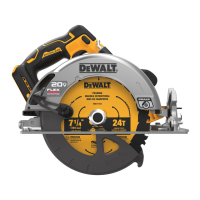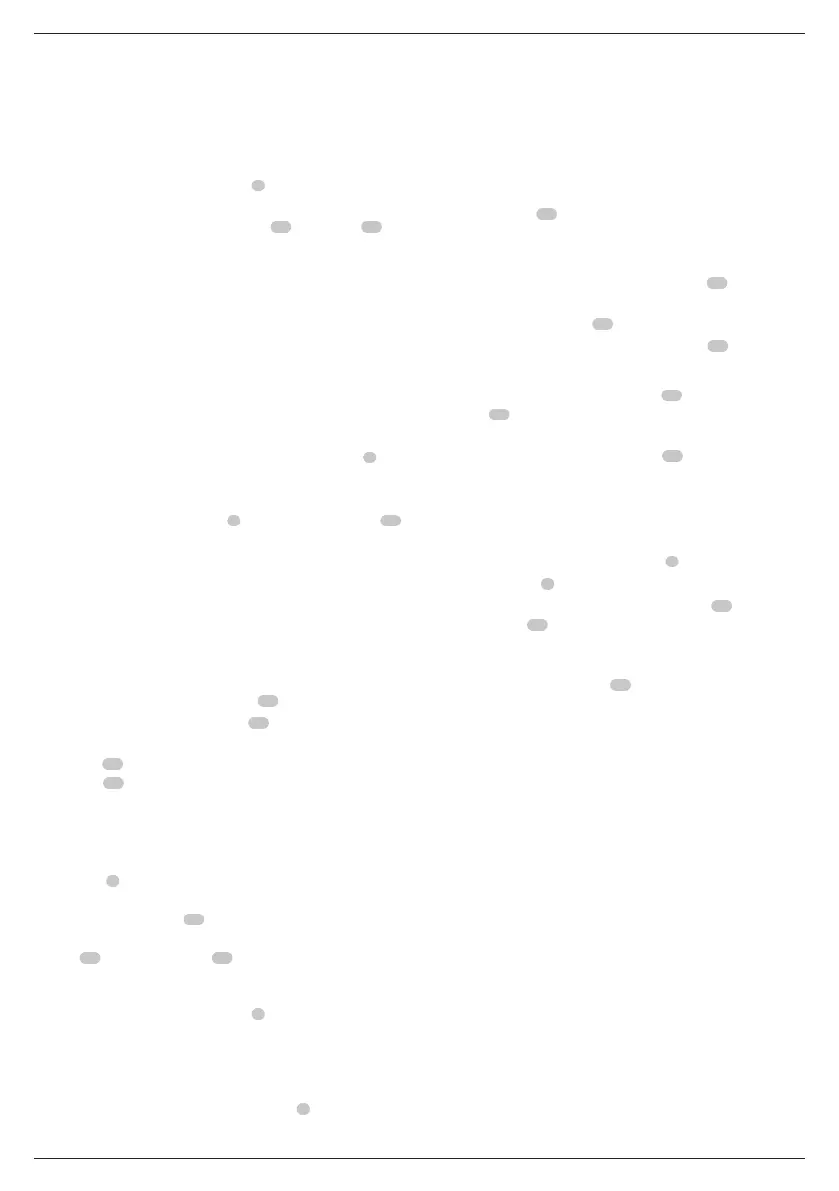15
ENGLISH
Proper Hand Position (Fig. J)
WARNING: To reduce the risk of serious personal injury,
ALWAYS use proper hand position asshown.
OPERATION
Instructions for Use
WARNING: Always observe the safety instructions and
applicableregulations.
WARNING: To reduce the risk of serious personal
injury, turn tool off and disconnect battery pack
before making any adjustments or removing/
installing attachments or accessories. An accidental
start‑up can causeinjury.
along cutting lines penciled on the material being cut.The kerf
indicator lines up with the left(outer) side of the saw blade,
which makes the slot or “kerf” cut by the moving blade fall to the
right of the indicator.Guide along the penciled cutting line so
that the kerf falls into the waste or surplus material.
Mounting and Adjusting the Parallel
Fence (Fig. N)
The parallel fence
22
is used for cutting parallel to the edge of
theworkpiece.
Mounting
1. Slacken the parallel fence adjustment knob
23
to allow the
parallel fence topass.
2. Insert the parallel fence
22
in the shoe asshown.
3. Tighten the parallel fence adjustment knob
23
.
Adjusting
1. Slacken the fence adjustment knob
23
and set the parallel
fence
22
to the desired width.The adjustment can be read
on the parallel fencescale.
2. Tighten the fence adjustment knob
23
Mounting the Dust Extraction Port (Fig. A, P)
Your circular saw is supplied with a dust extractionport.
To Install the Dust Extraction Port
1. Fully loosen depth adjustment lever
4
.
2. Place the shoe
5
in the lowestposition.
3. Align the left half of the dust extraction port
24
over upper
blade guard
36
as shown.Be sure to insert the tab into the
casting notch on the tool.When installed correctly, it will
snap fully over the original depth of cutpointer.
4. Align the right‑hand piece
37
with theleft.
5. Insert screws and tightensecurely.
Prior to Operation
• Make sure the guards have been mounted correctly.The saw
blade guard must be in closedposition.
• Make sure the saw blade rotates in the direction of the arrow
on theblade.
• Do not use excessively worn sawblades.
Any other conditions which could result in pinching,
binding, twisting, or misalignment of the blade could cause
kickback.Refer to the sections Further Safety Instructions for
All Saws and Blades for procedures and techniques that will
minimize the occurrence ofkickback.
Depth of Cut Adjustment (Fig. E, F)
1. Raise the depth adjustment lever
4
toloosen.
2. To obtain the correct depth of cut, align the appropriate
mark on the depth adjustment strap
30
with notch
31
on
the upper bladeguard.
3. Tighten the depth adjustmentlever.
4. For the most efficient cutting action using a carbide tipped
saw blade, set the depth adjustment so that about one half
of a tooth projects below the surface of the wood to becut.
5. A method of checking for the correct cutting depth is
shown in FigureF. Lay a piece of the material you plan to
cut along the side of the blade, as shown in the figure, and
observe how much tooth projects beyond thematerial.
Adjusting Depth Adjustment Lever(Fig.E)
It may be desirable to adjust the depth adjustment lever
4
.It
may loosen in time and hit the shoe beforetighten ing.
To Tighten the Lever:
1. Hold depth adjustment lever
4
and loosen the locknut
32
.
2. Adjust the depth adjustment lever by rotating it in the
desired direction about 1/8 of arevolution.
3. Retightennut.
Bevel Angle Adjustment (Fig. A, G)
The bevel angle adjustment mechanism can be adjusted
between 0° and 57°.
To achieve better accuracy in cutting, use the fine adjustment
markings located on the pivot bracket
33
.
1. Raise the bevel adjustment lever
10
toloosen.
2. Tilt the shoe to the desired angle by aligning the fine bevel
pointer
35
with the desired angle mark on the pivot
bracket
33
.
3. Lower the bevel adjustment lever toretighten.
Bevel Detent (Fig. A, G)
The DCS573 is equipped with a bevel detent feature.As you
tilt the shoe
5
you will hear a click and feel the shoe stop
at both 22.5 and 45degrees.If either of these is the desired
angle, retighten the lever
10
by lowering it.If you desire
another angle, continue tilting the shoe until the coarse bevel
pointer
34
or the fine pointer
35
aligns with the desiredmark.
Cut Length Indicator (Fig. A)
The markings on the side of the shoe
5
show the length of the
slot being cut into the material at the full depth of the cut.The
markings are in increments of 5mm.
Kerf Indicator (Fig. I)
The front of the saw shoe has a kerf indicator
9
for vertical
and bevel cutting.This indicator enables you to guide the saw

